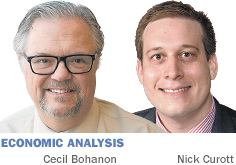Subscriber Benefit
As a subscriber you can listen to articles at work, in the car, or while you work out. Subscribe Now Ronald Reagan’s 1981 federal individual income tax reductions passed the House of Representatives with a majority of Democrats and all but one Republican voting yes. No one believes that will happen today. So what gives? Why aren’t tax cuts popular?
Ronald Reagan’s 1981 federal individual income tax reductions passed the House of Representatives with a majority of Democrats and all but one Republican voting yes. No one believes that will happen today. So what gives? Why aren’t tax cuts popular?
A number of reasons: Donald Trump is not Ronald Reagan; Nancy Pelosi is not Tip O’Neill; federal debt is much higher today relative to GDP. But as a couple of public-finance geeks, we did some tax accounting that gives a better answer.
Consider the bottom half of income earners filing tax returns. In 1980, these earners accounted for 7.2 percent of all federal individual income tax revenue collected. By 2014, their share was just 2.7 percent. In 1980, around 23 percent of the population resided in households that paid no federal income tax. By 2011, that had risen to 45 percent.
Although often characterized as a sop for the rich, the Reagan and subsequent tax cuts dramatically lowered the federal income tax burden of the lower half of income earners. In 1980, the lower half paid an average of 6.25 percent of their earnings in federal income taxes. By 2014, that had dropped to 3.14 percent. In contrast, those in the top 10 percent have seen their average tax liability drop from 23.5 percent of their income in 1980 to 21.4 percent in 2014. A decline, for sure, but hardly the halving of the average tax rate the bottom half enjoyed.
The irony is, this history makes additional tax cuts less politically attractive today. There’s just not much tax liability to cut for the bottom half, making it unlikely they are going to get excited about tax cuts at all. All sides agree there is a pressing need to reduce the corporate tax rate. But who will storm the barriers for a corporate tax cut?
So it looks like the GOP will do what it has always done: Offer zero taxes to an increasing proportion of the population to buy growth-enhancing tax cuts elsewhere. In 1980, a family of four with as little as $22,000 in adjusted gross income in today’s dollars paid some federal income tax. Under the current GOP plan, a similar household with $50,000 will pay nothing. In return, the corporate tax rate will be cut from 35 percent to 20 percent. Smart for the economy today—maybe—but don’t expect another tax reform until the 22nd century.•
__________
Bohanon and Curott are professors of economics at Ball State University. Send comments to [email protected].
Please enable JavaScript to view this content.
